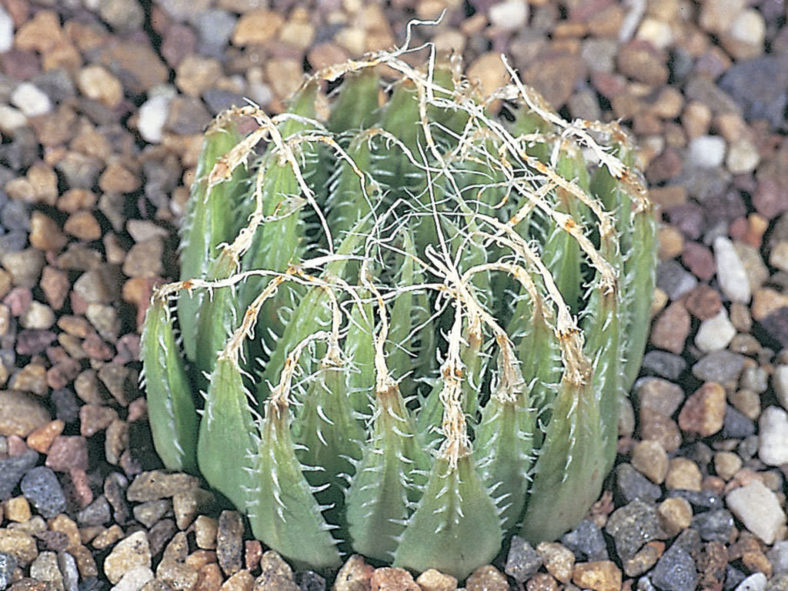Scientific Name
Haworthia decipiens var. minor M.B.Bayer
Synonym(s)
Haworthia gracilis var. minor
Scientific Classification
Family: Asphodelaceae
Subfamily: Asphodeloideae
Tribe: Aloeae
Genus: Haworthia
Etymology
The varietal epithet "minor (MY-nor)" is a Latin adjective meaning "less, lesser, inferior, smaller" and refers to the size of the variety, which is smaller compared to the type variety.
Origin
Haworthia decipiens var. minor is native to South Africa. It occurs in the Groot River valley between the ranges in the Eastern Cape province.
Description
Haworthia decipiens var. minor is a small succulent that forms stemless, slowly proliferous rosettes of thick, fleshy, broadly ovate leaves with sparse or sometimes no spines on keels and margins. It differs from Haworthia decipiens var. decipiens mainly in having much smaller rosettes. Its leaves are incurved and lighter green. The rosettes can grow up to 2.4 inches (6 cm) in diameter.
The white flowers with greenish-brown venation appear densely arranged on slender, unbranched stalks from spring to fall.

How to Grow and Care for Haworthia decipiens var. minor
Light: Place the potted plant in a bright area with some protection from the hottest rays of the day. White, yellow, or red-tinged leaves usually indicate that your H. decipiens var. minor receives too much sunlight. Deep shade tends to weaken the plant over a prolonged period. If your plant has spent the winter indoors, gradually move it outdoors into the bright sun to prevent sunburn.
Soil: Like all Haworthias, this plant does not like its roots to remain wet for prolonged periods, so the soil should be well-drained. Use a commercial potting mix for succulents, or make your own.
Temperature: This succulent likes warmer in the summer but cool temperatures in the winter. However, it does not like being too cold. H. decipiens var. minor can withstand temperatures as low as 30 °F (-1.1 °C). USDA Plant Hardiness Zones 10a to 11b, 30 to 50 °F (-1.1 to 10 °C).
Watering: In spring and fall, when the growth is most active, water H. decipiens var. minor thoroughly, then wait until the top of the soil dries out before watering again. Water your plant less during the winter when its growth slows down significantly. When this plant is mostly dormant during the hottest summer months, water it just enough to keep the leaves from shriveling.
Fertilizing: H. decipiens var. minor does not require much fertilizer. However, for optimum growth, fertilizing is a good idea. Feed only with a dilute fertilizer and only during the active growing season.
Repotting: This slow-growing succulent can stay in the same pot for years. To keep your plant healthy and happy, repot H. decipiens var. minor into fresh soil every two to three years in spring or fall. Repotting time is also the time to take offsets for propagation.
Propagation: The quickest and most common method of propagating H. decipiens var. minor is by offsets. It can also be propagated by leaves and seeds. Remove the offsets when they have started developing their own roots. Sow the seeds in spring or fall in a well-draining soil mix.
Learn more at How to Grow and Care for Haworthia.
Toxicity of Haworthia decipiens var. minor
H. decipiens var. minor is considered non-toxic to humans and animals.
Links
- Back to genus Haworthia
- Succupedia: Browse succulents by Scientific Name, Common Name, Genus, Family, USDA Hardiness Zone, Origin, or cacti by Genus
Photo Gallery
Click on a photo to see a larger version.


